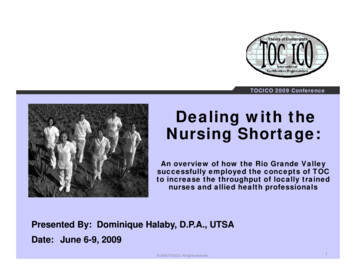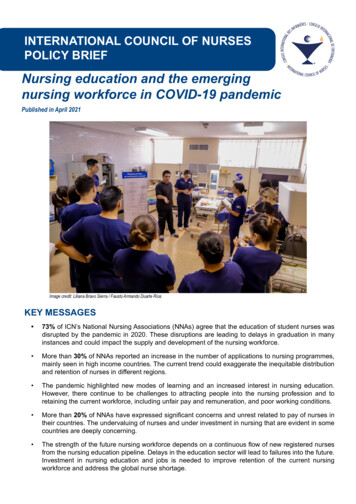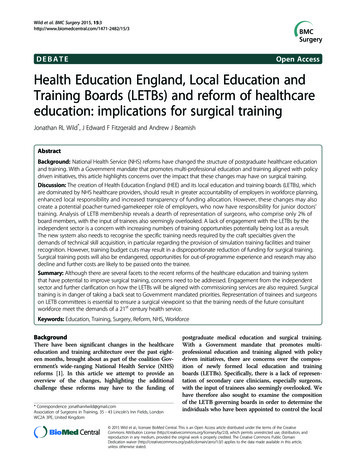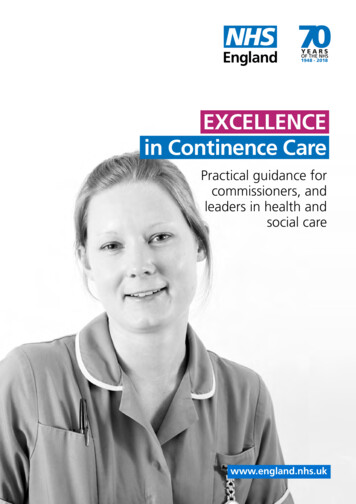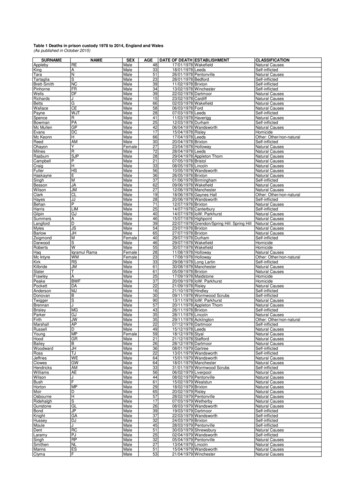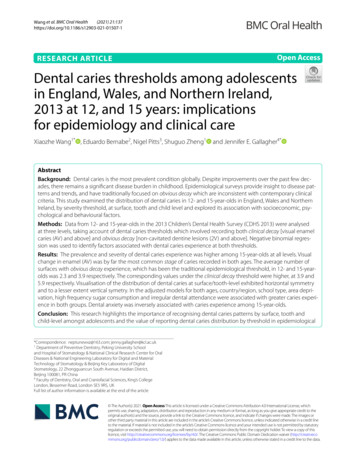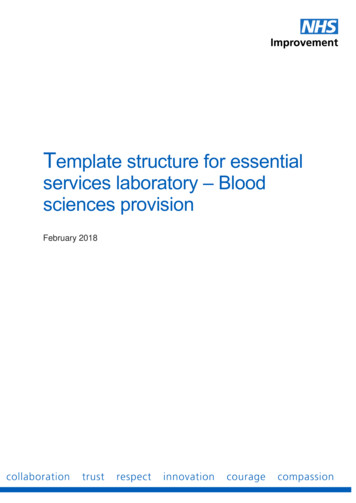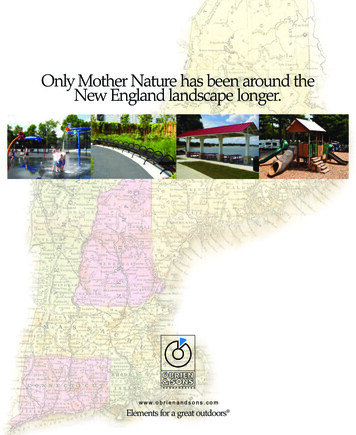
Transcription
DEBATE PACKNumber CDP-2020/0037, 28 February 2020Nursing workforceshortage in EnglandBy Melissa Macdonald,Carl BakerContentsSummaryThere will be a debate in Westminster Hall on Tuesday 3 March at 9.30am on'Nursing workforce shortage in England'. The debate will be led by MohammadYasin MP. This debate pack provides some background information on theseissues and brings together related news articles, press releases andparliamentary material1.Background2.Nursing vacancy rates33.CQC’s State of CareReport 2018/194Responses to workforcechallenges43.14.4.14.24.35.Interim NHS PeoplePlanPrioritise urgent actionon nursing shortagesActions to be taken in2019/20Suggested actions forfull People Plan5569Other measuresannounced by theGovernmentNursing grantNHS fast-track visaPoints-basedimmigration system1010116.6.16.26.36.4Further readingLibrary publicationsSector commentNews al questionsWritten questionsDebates171717195.15.25.3The House of Commons Library prepares a briefing in hard copy and/or online formost non-legislative debates in the Chamber and Westminster Hall other thanhalf-hour debates. Debate Packs are produced quickly after the announcement ofparliamentary business. They are intended to provide a summary or overview ofthe issue being debated and identify relevant briefings and useful documents,including press and parliamentary material. More detailed briefing can beprepared for Members on request to the y intranet.parliament.uk/commons-library papers@parliament.uk @commonslibrary12
2Number CDP-2020/0037, 28 February 20201. BackgroundThe need to recruit and retain an adequate health and care workforcehas been described by many commentators as the greatest challengecurrently facing the NHS. 1 The Care Quality Commission’s State of Carereport for 2018/19 stated that workforce problems are having a directimpact on care.Nursing is facing one of the greatest recruitment problems and NHShospitals and mental health and community providers are currentlyreporting a shortage of around 40,000 full time equivalent (FTE) nurses.According to analysis conducted by The Health Foundation, The King’sFund and Nuffield Trust in 2019, on current trends, in 10 years’ time theNHS will have a shortfall of approximately 108,000 full-time equivalentnurses. 2The Government published an Interim People Plan in June 2019 whichidentified a need to prioritise urgent action on nursing shortages, and afull five-year People Plan is expected at some point this year. TheGovernment has also made a number of pledges related to the nursingworkforce, including an additional 50,000 nurses in the NHS by2024/25, introducing a nursing grant, and devising a fast-track visa forNHS workers, including nurses.2020 has been designated by the World Health Organisation as the firstever international Year of the Nurse and Midwife, and they havelaunched a “year-long effort to celebrate the work of nurses andmidwives, highlight the challenging conditions they often face, andadvocate for increased investments in the nursing and midwiferyworkforce”. 3 As part of this, NHS England have said it is a priority forthis year to “raise the profile of the rewarding careers that nursing andmidwifery can offer” 4 and have organised a range of events.1234The Economist, A shortage of staff is the biggest problem facing the NHS, 23 March2019Nuffield Trust, Closing the gap: Key areas for action on the health and careworkforce, 21 March 2019World Health Organisation, WHO Campaigns, Year of the Nurse and the Midwife2020NHS England, International year of the Nurse and Midwife 2020, News and updates
Nursing workforce shortage in England 32. Nursing vacancy ratesSince 2010, the nursing workforce in England’s hospitals has grownmore slowly than other staff groups. Between November 2010 andNovember 2019, the number of nurses grew by 6.2%, compared withan increase of 20.6% in the number of hospital doctors and 18.4% inthe number of qualified scientific, therapeutic and technical staff.However, over the last few months the nursing workforce has beengrowing at its fastest rate in the last decade. The number of nurses hasgrown by 3% between November 2018 and November 2019. InNovember 2019, there were 290,474 full-time equivalent nursesworking in the NHS.There were 38,785 nursing vacancies as of December 2019, and nursingvacancy rates remain higher than other staff groups. 10.7% of nursingposts were vacant in December 2019 compared with 6.6% of medicalposts and 8.1% of all NHS staff roles. This compares with a vacancy rateof 2.7% for the UK economy as a whole, according to ONS estimatesfor November 2019 to January 2020. 5Nursing vacancy rates fell year-on-year from 11.1% (39,686 posts) to10.7% (38,785). The table below shows the December 2019 nursingvacancy rate in different parts of England. The vacancy rate fell in fourregions, but not in in London, the Midlands, or North East & Yorkshire.Nursing vacancies in EnglandNumberNHS regionRateDec-18Dec-19Dec-18Dec-19East of .5%Midlands7,5497,81011.4%11.5%North East and Yorkshire4,6194,7298.1%8.2%North West5,2145,0569.6%9.2%South East6,0615,38813.0%11.3%South ndSources: NHS Digital, NHS Workforce Statistics November 2019; NHS VacancyStatistics5Office for National Statistics, Vacancies and jobs in the UK: February 2020, 18February 2020
4Number CDP-2020/0037, 28 February 20203. CQC’s State of Care Report2018/19The Care Quality Commission’s (CQC) ‘The state of health care andadult social care in England 2018/19’ report stated that “increaseddemand, combined with challenges around workforce and access, riskcreating a perfect storm”. 6 The report highlighted particular challengesfacing different regions and specialisms. The report highlights that overthe last five years, the total number of mental health nurses hascontinued to fall, with 2% fewer mental health nurses in April 2019compared with April 2014, with a sharper decline in inpatient mentalhealth nurses. However, over the same period, the numbers ofcommunity mental health nurses have increased, reflecting the policyshift away from hospital-based care. 7The CQC’s report highlights there is also regional variation in the abilityof services to recruit and retain staff, with different localities and partsof the system facing different workforce challenges. For example, thereport states:Our staff have reported that in hospitals and mental health care,areas in and next to London face specific issues linked to highercosts of living and pay disparities caused by the Londonweighting. 8The report also emphasises that staffing shortages can further increasethe strain on the workforce 9; and the 2019 NHS Staff Survey results alsofound that just over 40% of respondents said they had felt unwell as aresult of work-related stress in the previous 12 months. 103.1 Responses to workforce challengesThe CQC report outlines a number of responses that have beenimplemented across the NHS in response to workforce pressures. Theseinclude providing better opportunities for nurses and healthcareassistants to train and develop their careers. 11 Services are also trying tolimit staff turnover and shortages, and increase wellbeing, throughmore flexible working arrangements. 12 Increased demand on serviceshas also prompted the development of new roles, in primary care, suchas advanced nurse practitioners and nursing associates. The CQC reportnotes that the introduction of the nursing associate role has thepotential to create development opportunities for staff in both adultsocial care and health care. 13678910111213CQC, The state of health care and adult social care in England 2018/19, Summary,page 6CQC, The state of health care and adult social care in England 2018/19, page 58CQC, The state of health care and adult social care in England 2018/19, page 27CQC, The state of health care and adult social care in England 2018/19, page 26NHS Staff Survey 2019, National Results, National Trends, Questions 2019, q11cCQC, The state of health care and adult social care in England 2018/19, page 29CQC, The state of health care and adult social care in England 2018/19, page 28CQC, The state of health care and adult social care in England 2018/19, page 29
Nursing workforce shortage in England 54. Interim NHS People PlanThe Government published an Interim NHS People Plan in June 2019. Itwas aiming to publish a full five-year People Plan following thescheduled Spending Review, and it is now expected at some point thisyear.The Interim Plan is structured around the following themes:1Improve our leadership culture2Prioritise urgent action on nursing shortages3Develop a workforce to deliver 21st century care4Develop a new operating model for workforce5Take immediate action in 2019/20 while we develop a full fiveyear plan4.1 Prioritise urgent action on nursingshortagesThe Interim People Plan states that whilst there are significant staffshortages across the country in many parts of the workforce, it identifiesshortages in nursing as “the single biggest and most urgent we need toaddress”. 14 The Plan explains this is partly due to the absolute numbersof vacancies, but also because nurses “form a critical part of themultiprofessional team needed to deliver the NHS Long Term Plan”. 15The Plan states:We have vacancies across all areas of nursing, with the mostsignificant shortages in mental health, learning disability, primaryand community nursing. In hospital and community healthservices, there are around 40,000 reported vacancies insubstantive nursing posts (with around 80% of these shiftscurrently covered by bank and agency staff), and there are furtherpressures in primary care. 16The Plan set out that a “multifaceted and carefully co-ordinatedstrategy” 17 will be required to address this, with a focus on thefollowing:14151617 Increasing supply through undergraduate nursing degreecourses, as the largest and most effective supply route, andreducing attrition from training Providing clear pathways into the profession and furtherdeveloping additional entry routes through the nursingassociate qualification and apprenticeships Improving retention of our existing nursing workforce Supporting and encouraging more nurses to return topracticeNHS, Interim NHS People Plan, June 2019, page 20NHS, Interim NHS People Plan, June 2019, page 20NHS, Interim NHS People Plan, June 2019, page 20NHS, Interim NHS People Plan, June 2019, page 20
6Number CDP-2020/0037, 28 February 2020 Ensuring that any nurses wishing to increase their part-timeworking hours are able to do so Providing continuing support to our people to develop theircareers and their skills to respond to the changing needs ofpatients and citizens Continuing to focus on safe and effective staffing, buildingon existing policy and support to boards and staff inmaking effective decisions.Given the lead times for training new nurses, we also need toincrease international recruitment in the short to medium term toincrease supply rapidly.We consider that these actions will enable to the NHS to grow thenursing workforce by over 40,000 by 2024, enabling us to keeppace with rising demand and make initial progress in bringingdown substantive vacancy levels. The full People Plan will need tocontain further action to enable us to go further in reducingsubstantive vacancy levels and reducing reliance on temporarystaff, with the proposed aim of reducing vacancy levels to 5% by2028. 184.2 Actions to be taken in 2019/20The plan goes on to outline the actions that can be taken immediatelyto address the nursing workforce shortage. The key actions aresummarised below.RetentionThe plan identifies retention of current nurses as the most immediateaction that can be taken. It notes that NHS Improvement, in partnershipwith NHS Employers, launched a National Retention Programme in2017. The programme has reportedly seen turnover rates reduce from12.5% to 11.9% nationally. 19The Direct Support Programme forms part of the National RetentionProgramme, and offers targeted, clinically-led support focusing onnursing and clinical staff turnover rates. Trusts are supported“intensively for 90 days to develop retention improvement plans, whichmust aim to improve turnover rates in 12 months”. 20 The plans haveincluded initiatives around improving inductions, extendingpreceptorships, and increasing flexible working opportunities. 21Actions in 2019/20:18192021 Significantly expand our Direct Support Programme to alltrusts to improve retention, with a focus on supportingearly years retention and reviewing best practice inpreceptorship arrangements. Work with primary care to extend the retention programmeinto general practice, in addition to incentives to supportentry to and return to general practice nursing.NHS, Interim NHS People Plan, June 2019, page 21NHS Improvement, The national retention programme two years on, 12 July 2019NHS Improvement, The national retention programme two years on, 12 July 2019NHS Improvement, The national retention programme two years on, 12 July 2019
Nursing workforce shortage in England 7 Provide additional hands-on support in specialised areaswhere the need is greatest, including high secure hospitalsand emergency departments.Increasing undergraduate supplyThe Interim People Plan notes that undergraduate degrees are currentlythe largest and most effective entry route into the nursing profession. 22However, it takes three years for a student to qualify through anundergraduate programme, with the potential for a two-yearqualification through postgraduate routes resulting in an unavoidabletime lag. 23Actions in 2019/20: Deliver a rapid expansion programme to increase clinicalplacement capacity by 5,000 for September 2019 intakes.We will work directly with trust directors of nursing toassess organisational re
Nursing is facing one of the greatest recruitment problems and NHS hospitals and mental health and community providers are currently reporting a shortage of around 40,000 full time equivalent (FTE) nurses. According to analysis conducted by The Health Foundation, The King’s Fund and Nuffield Trust in 2019, on current trends, in 10 years’ time the NHS will have a shortfall of approximately .
